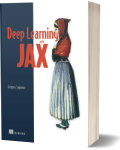Deep Learning with JAX Edition: 1
Artificial Intelligence
Book Details
Book Title
Deep Learning with JAX Edition: 1
Author
Grigory Sapunov
Publisher
Manning City: Shelter Island, NY
Publication Date
2024
ISBN
9781633438880
Number of Pages
410
Language
English
Format
File Size
3MB
Subject
Computers > Cybernetics: Artificial Intelligence
Table of Contents
- Deep Learning with JAX
- brief contents
- contents
- preface
- acknowledgments
- about this book
- about the author
- about the cover illustration
- Part 1
- Chapter 1: When and why to use JAX
- 1.1 Reasons to use JAX
- 1.2 How is JAX different from NumPy?
- 1.3 How is JAX different from TensorFlow and PyTorch?
- Chapter 2: Your first program in JAX
- 2.1 A toy ML problem: Classifying handwritten digits
- 2.2 An overview of a JAX deep learning project
- 2.3 Loading and preparing the dataset
- 2.4 A simple neural network in JAX
- 2.5 vmap: Auto-vectorizing calculations to work with batches
- 2.6 Autodiff: How to calculate gradients without knowing about derivatives
- 2.7 JIT: Compiling your code to make it faster
- 2.8 Saving and deploying the model
- 2.9 Pure functions and composable transformations: Why are they important?
- Part 2
- Chapter 3: Working with arrays
- 3.1 Image processing with NumPy arrays
- 3.2 Arrays in JAX
- 3.3 Differences from NumPy
- 3.4 High-level and low-level interfaces: jax.numpy and jax.lax
- Chapter 4: Calculating gradients
- 4.1 Different ways of getting derivatives
- 4.2 Calculating gradients with autodiff
- 4.3 Forward- and reverse-mode autodiff
- Chapter 5: Compiling your code
- 5.1 Using compilation
- 5.2 JIT internals
- 5.3 JIT limitations
- Chapter 6: Vectorizing your code
- 6.1 Different ways to vectorize a function
- 6.2 Controlling vmap() behavior
- 6.3 Real-life use cases for vmap()
- Chapter 7: Parallelizing your computations
- 7.1 Parallelizing computations with pmap()
- 7.2 Controlling pmap() behavior
- 7.3 Data-parallel neural network training example
- 7.4 Using multihost configurations
- Chapter 8: Using tensor sharding
- 8.1 Basics of tensor sharding
- 8.2 MLP with tensor sharding
- Chapter 9: Random numbers in JAX
- 9.1 Generating random data
- 9.2 Differences with NumPy
- 9.3 Generating random numbers in real-life applications
- Chapter 10: Working with pytrees
- 10.1 Representing complex data structures as pytrees
- 10.2 Functions for working with pytrees
- 10.3 Creating custom pytree nodes
- Part 3
- Chapter 11: Higher-level neural network libraries
- 11.1 MNIST image classification using an MLP
- 11.2 Image classification using a ResNet
- 11.3 Using the Hugging Face ecosystem
- Chapter 12: Other members of the JAX ecosystem
- 12.1 Deep learning ecosystem
- 12.2 Machine learning modules
- 12.3 JAX modules for other fields
- Appendix A: Installing JAX
- Appendix B: Using Google Colab
- Appendix C: Using Google Cloud TPUs
- Appendix D: Experimental parallelization
- Index
